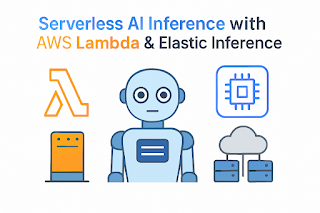Serverless AI Inference with AWS Lambda & Elastic Inference
Meta Description:
Discover how to deploy machine learning models in a fully serverless environment using AWS Lambda and Elastic Inference. Learn best practices, architecture patterns, latency optimizations, and cost-saving techniques for scalable AI inference.
Tags:
AWS Lambda, Elastic Inference, Serverless AI, Machine Learning, Cloud Inference, Real-Time AI
Keywords:
Serverless AI inference, AWS Lambda machine learning, Elastic Inference AWS, deploy ML model serverless, real-time inference AWS
🧠 Introduction
Running inference on machine learning models traditionally requires provisioning compute-heavy infrastructure, especially for deep learning. But what if you could skip managing servers altogether while still achieving near real-time inference?
That’s where AWS Lambda + Elastic Inference (EI) shines—a serverless architecture that lets you scale inference without worrying about infrastructure while reducing GPU costs. As an enterprise AI architect, I’ve implemented this architecture for various microservices, including NLP models in real-time chatbots and lightweight vision models for event-triggered IoT applications.
This guide explains how to architect, deploy, and optimize serverless AI inference using AWS Lambda and Elastic Inference.
This is a very key aspect when we are automating for AI use cases. This infrastructure is scalable and has lot of advantages.
Please do refer to the diagram in the blog down for reference on Architecture
⚙️ Why Use Serverless for Inference?
✅ Benefits:
-
No infrastructure management
-
Auto-scaling per request
-
Cost-effective with pay-per-use
-
Easy integration with other AWS services
🧨 Challenges:
-
Cold starts
-
Memory and duration limits
-
Packaging large ML models
🔧 Elastic Inference: The Secret Ingredient
AWS Lambda alone doesn’t support GPU acceleration, but Elastic Inference bridges the gap. It attaches low-cost inference accelerators to EC2 or ECS instances and allows you to serve deep learning models (e.g., TensorFlow, MXNet) with GPU-like performance at a fraction of the cost.
While EI isn’t directly supported with Lambda, we architect a bridge using an intermediary service—like ECS Fargate or EC2—that runs the model with EI, and Lambda sends inference requests.
🏗️ Architecture Overview
Components:
-
Lambda Function
Handles incoming requests, pre/post-processing, and routes to the inference service. -
Elastic Inference-Enabled EC2 or ECS Fargate
Runs the model on a deep learning container with TensorFlow or PyTorch using EI. -
API Gateway
Exposes a public endpoint and triggers Lambda. -
S3
Stores model weights, logs, or incoming payloads. -
CloudWatch
Monitors performance, logs, and triggers alerts.
🔁 Architecture Flow:
-
User sends a request to API Gateway.
-
API Gateway invokes AWS Lambda.
-
Lambda function validates and pre-processes the input.
-
Lambda sends the data to an EC2/ECS endpoint running the model with Elastic Inference.
-
EC2/ECS performs inference and returns the result.
-
Lambda post-processes and returns the response.
🧪 Real-World Example: Serverless Sentiment Analysis API
We deployed a lightweight BERT model for customer sentiment classification.
Breakdown:
-
Model: DistilBERT (90MB), converted to TensorFlow SavedModel
-
EC2: t3.large instance with Elastic Inference Accelerator
eia2.medium -
Latency: ~200ms per request (95th percentile)
-
Cost: ~70% cheaper than GPU-based EC2 inference servers
🚀 Deployment Steps
Step 1: Prepare the Model
Use TensorFlow or PyTorch and export your model to a SavedModel format:
Upload the model to Amazon S3 for later loading.
Step 2: Setup EC2 Inference Service with EI
-
Launch an EC2 instance with Elastic Inference Accelerator.
-
Install TensorFlow EI and serve using TensorFlow Serving:
-
Start the server:
Elastic Inference auto-attaches to TensorFlow backend if properly configured.
Step 3: Create the Lambda Function
-
Write a lightweight Lambda handler in Python:
-
Package dependencies with Docker or use Lambda Layers.
Step 4: Expose via API Gateway
-
Create a REST API in API Gateway.
-
Set POST method to trigger Lambda.
-
Enable CORS if needed.
-
Deploy to a stage and obtain a public endpoint.
⚡ Performance Optimization Tips
✅ Cold Start Mitigation
-
Use provisioned concurrency in Lambda to reduce cold starts.
-
Keep Lambda under 250MB unzipped size to avoid longer cold starts.
-
Minimize packages and use lightweight tokenizer libraries.
✅ Async Inference Option
-
Use SQS or EventBridge to queue requests.
-
Let Lambda enqueue, and ECS/EC2 handle inference asynchronously for large jobs.
✅ Use EI Intelligently
-
Match EI type with model size:
-
eia2.medium: small BERT or CNNs -
eia2.large: medium ResNet or GPT-2 -
eia2.xlarge: heavy LSTM/Transformer models
-
📊 Monitoring & Observability
-
CloudWatch Logs: Log request payloads and errors from Lambda and EC2.
-
CloudWatch Metrics: Create dashboards for latency, throughput, and errors.
-
X-Ray: Trace Lambda + EC2 call chain.
-
Alarms: Trigger alerts if 95th percentile latency > 500ms.
🧠 What We Learned
-
Serverless inference is real. For low-to-medium load inference APIs, this approach is not only viable—it’s cost-effective.
-
Elastic Inference bridges the gap between Lambda's limitations and real-time deep learning workloads.
-
Cold starts and packaging are the main limitations—but manageable with best practices.
📎 Diagram: Serverless AI Inference Architecture
🧭 Next Steps
-
Explore Lambda + Sagemaker Endpoint combo for heavier models.
-
Use AWS Step Functions to chain inference + post-processing.
-
Add token bucket rate limits to manage burst traffic from frontend apps.
🔚 Conclusion
Serverless inference using AWS Lambda and Elastic Inference allows you to deliver AI at scale without servers, while minimizing cost and complexity. From NLP chatbots to vision-based edge detection systems, this architecture pattern supports fast, scalable deployments for modern applications.
If you're working with tight budgets or highly dynamic workloads, it's time to go serverless with AI.
🔗 Like This? Read Next: In my blog - previous topic
-
“Designing Scalable MLOps Pipelines on Kubernetes”





Comments
Post a Comment